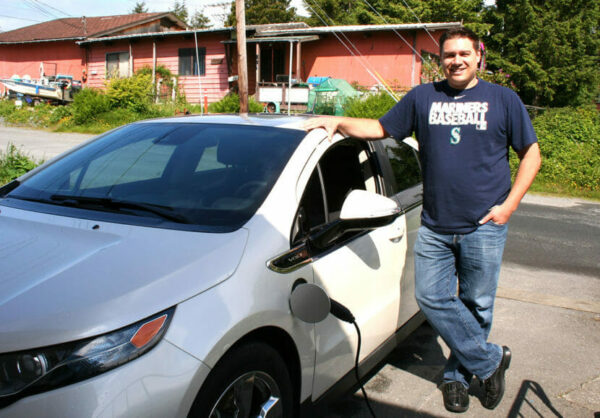
A Sitka organization is working with the Alaska Energy Authority to install a mostly federally funded electric vehicle charger in the community. But figuring out where to put it is a complicated problem. An electric vehicle advocate from Juneau recently offered his advice on the question.
In pure numbers, Sitka a national leader for EV ownership. But there isn’t a single public charging station.
“If you were your own state, you would be beating California right now, in terms of EV adoption,” EV advocate Devon Kibby said. “Hardily beating California.”
Kibby is an electrical engineer and the founder of the Alaska Electric Vehicle Association, a nonprofit, all-volunteer advocacy organization for electric cars, trucks and buses. He says that, based on the latest data from the Division of Motor Vehicles, Sitka had 126 electric vehicles — 90% of them Nissan Leafs. That’s 15 for every 1,000 people in Sitka. Elsewhere in the state, that number drops down to around two.
Barb Bingham said the community had unique characteristics that made electric vehicles attractive for many residents — but the absence of public charging stations is a problem for some.
“I think we lead the nation because we’re at 14 miles of highway,” said Bingham. “But I think for commercial businesses with light duty fleets, apartment dwellers, and liveaboards in the harbor that would like to have electric vehicles — and for most of us who trickle charge — it would be nice to be able to do a fast charge once in a while.”
Bingham was one of the co-hosts of a presentation organized by Transition Sitka on May 23 to hear from Kibby about his work advocating for Juneau’s 19 public charging stations. Kibby bought a Leaf in 2014 and said he was okay charging it at home overnight from a regular electrical outlet.
But as Juneau’s population of electric vehicles grew, so did the need for public infrastructure.
“Sometimes my car doesn’t get plugged in at night — I forget,” Kibby said. “And then secondly — and the thing that we’ve been working more on in Juneau lately — is people who don’t have garages. So apartment dwellers, people in the downtown core of Juneau who don’t have off-street parking: How to help them go EV.”
80% of the cost of Sitka’s first-ever public charging station will be covered by the Alaska Energy Authority, which is using funding from the federal infrastructure bill to install public charging stations along every fifty miles of national highway in the state. That qualifies Sitka for exactly one charger — Sitka’s “national highway” runs from the roundabout to the airport.
Now it’s a matter of figuring out where to put it. The site must have access to power. And if it’s on private property, it will require the cooperation of land owners.
What likely won’t be needed is any high-tech networking equipment or credit card readers. Kibby said that the best value has proven to be charging cars for free.
“When people plug into these level 2 chargers for an hour, the cost for the electricity is a couple dollars at most,” he said. “And we found in the beginning that the cost to charge someone a few dollars exceeded the cost of electricity itself.”
Kibby said that Juneau’s first chargers were second-hand and came with ports that may become obsolete when electric vehicles eventually adopt a standard. Sitka’s charger will have four ports and will have to be more advanced by necessity, as electric vehicle battery capacity has grown massively.
Kibby’s 2014 Leaf had a battery capacity of 24 kilowatt hours. A new Chevy Bolt has about two-and-a-half times that. A new Rivian pickup truck comes with a staggering 180 kilowatt battery. A level 2 charger draws about as much power as a clothes dryer but can still take a long time to replenish those huge battery packs.
Kibby said this has forced a change in Juneau’s approach since the first public charging stations were installed in 2017.
“When you used to go and plug your Leaf in for an hour, and you’d recover about 25% of your charge,” Kibby said. “And that seems like a lot. A quarter of your battery was replenished in an hour. But with these newer vehicles that are coming out, we’re starting to think more about how they’re going to need to be plugged in longer but less frequently compared to the Leaf.”
Transition Sitka organizers conducted a brief straw poll among attendees at the presentation about their preferred location for Sitka’s lone, federally funded public charging station. There wasn’t a clear consensus.
Kibby urged Sitkans to consider what they wanted to accomplish with the charging station.
“Is it going to charge personal light-duty vehicles, or allow the electrification of some commercial fleet?” he asked. “What in your mind is the best use, or low-hanging fruit, of the electrification sector that could occur because of this station, considering that you guys already have nation-leading adoption (of EVs) with no public chargers?”
[Sign up for Alaska Public Media’s daily newsletter to get our top stories delivered to your inbox.]
Robert Woolsey is the news director at KCAW in Sitka.




